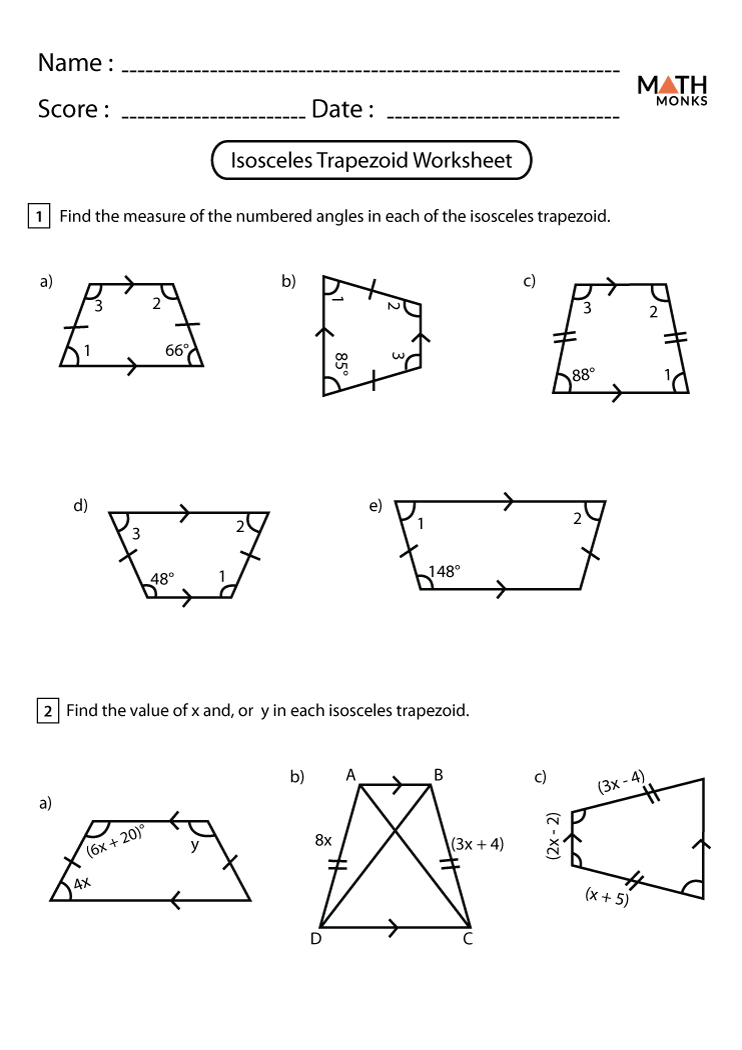Remember that moment in geometry class where you felt that sinking feeling as the teacher introduced trapezoids and kites? Maybe you thought, “Why do we need to learn about these shapes? They’re just… weird.” But hold on, these shapes are anything but bizarre. Trapezoids and kites, in their own unique ways, contribute hugely to the fascinating world of geometry, and understanding them can actually be surprisingly fun! This article will dive deep into the fascinating world of trapezoids and kites, demystifying their properties, exploring their real-world applications, and providing you with answers to those tricky worksheets.

Image: www.pinterest.com
So, let’s embark on a journey of discovery, where we’ll unravel the secrets of these captivating shapes and equip you with the knowledge to tackle any geometry challenge related to trapezoids and kites. Buckle up, it’s about to get geometrically exciting!
Defining the Basics: Trapezoids and Kites
Let’s start with the foundational definitions. A trapezoid is a quadrilateral (a four-sided shape) with at least one pair of opposite sides parallel. Imagine a table with two sides perfectly parallel—that’s a trapezoid! But here’s where it gets interesting: there are two types of trapezoids:
- Isosceles Trapezoid: This one has two equal non-parallel sides, often resembling a symmetrical table.
- Scalene Trapezoid: Here, all the sides have different lengths, creating a more “asymmetrical” look.
Now, consider a kite, another four-sided shape. Unlike the trapezoid, the kite’s defining characteristic is its pairs of adjacent sides that are equal in length. Think of a kite you might fly in the wind – the two sides on either side of its center are equal, and so are the other two sides.
Understanding their Key Properties
Now that we’ve defined these shapes, let’s delve into their distinctive properties.
Trapezoids:
- Area: To calculate the area of a trapezoid, you can use the formula: Area = (1/2) (sum of parallel sides) (height). The height is the perpendicular distance between the parallel sides.
- Midsegment: A trapezoid’s midsegment, a line connecting the midpoints of the non-parallel sides, is parallel to both parallel sides and its length is equal to the average of the lengths of the two parallel sides.
- Angles: The angles on the same side of the non-parallel sides are supplementary (add up to 180 degrees). This means that if one of these angles is 60 degrees, the other will be 120 degrees.
Kites:
- Area: The area of a kite can be calculated using the formula: Area = (1/2) (product of diagonals)*. The diagonals are the lines that connect opposite vertices (corners) of the kite.
- Diagonals: One important property of a kite is that its diagonals are perpendicular. These diagonals also bisect each other, meaning they are divided into two equal parts at their intersection point.
- Symmetry: Kites possess one line of symmetry, which passes through the intersection of its diagonals.
Real-World Applications of Trapezoids and Kites
You might be thinking, “Why do I need to know all this?” Well, these geometric shapes are actually found everywhere around us!
Trapezoids:
- Architecture: From buildings and bridges to staircases and roofs, trapezoids are commonly used in architectural design. Their shape provides strength and structural stability.
- Engineering: In mechanical engineering, trapezoids appear in various mechanical components like gears, belts, and even in the design of wind turbines.
- Everyday Objects: Look around – you’ll find trapezoids in pizza slices, bookcases, and even in the shape of a slice of cake!
Kites:
- Wind Energy: Although not directly a kite, the design of a wind turbine utilizes the principle of kite geometry for optimal air capture.
- Art and Design: You’ll find kites appearing in various art forms, from stained glass windows to intricate mosaics.
- Nature: The shape of a kite can be observed in the wings of certain bird species, maximizing their flight efficiency.

Image: printablelibsinky.z13.web.core.windows.net
Mastering the Worksheets: A Guide to Success
Now, let’s dive into the practical aspects – solving those geometry worksheets dedicated to trapezoids and kites. Here are some tips to help you conquer any problem:
Trapezoid Worksheets:
- Identify the Properties: First things first – identify the type of trapezoid (isosceles or scalene) and then focus on the specific properties required in the problem.
- Use the Formulas: Remember the area formula and the properties of the midsegment. If you’re given the height and the lengths of the parallel sides, you can easily calculate the area.
- Angle Relationships: Don’t forget the supplementary angle relationship. If you’re given one angle, you can calculate the other.
Kite Worksheets:
- Focus on the Diagonals: The diagonals are your key to solving most kite problems. Remember they are perpendicular and bisect each other.
- Use the Area Formula: When you need to find the area, multiply the lengths of the diagonals and divide by two.
- Symmetry: Remember that the kite has only one line of symmetry which passes through the intersection of its diagonals.
Where to Find Answer Keys and More Practice:
You can find a wealth of resources online for extra practice and helpful answers:
- Online Geometry Worksheets: Websites dedicated to math education offer free printable worksheets with answers. Search for “trapezoid worksheets” or “kite worksheets” along with “answers” to find these resources.
- Khan Academy: This free online education platform provides interactive lessons and practice problems on trapezoids and kites.
- Math Textbooks: Check your geometry textbook or online textbook resources for additional practice questions and answer keys.
Geometry Trapezoid And Kite Worksheet Answers Pdf
Conclusion: Unlocking the Geometric Wonders of Trapezoids and Kites
By understanding the properties of trapezoids and kites, you’ve unlocked a new dimension of geometric knowledge. With a bit of practice, you’ll not only ace those worksheets but also gain an appreciation for these shapes that influence our world in surprising ways. Don’t be afraid to delve deeper, explore online resources for more practice, and you’ll be well on your way to becoming a true geometry champion!






